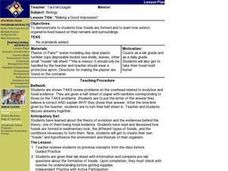Curated OER
What's the Matter with My Orange?
Students use oranges to informally explore decomposition, dehydration, fermentation, the water cycle, bacteria, yeast, food webs, the needs of living things, and physical vs. chemical change over a period of three or more months.
Curated OER
Tracking in Wisconsin
Students examine how to identify the tracks and track patterns of some common Wisconsin animals. They examine how the footprints of these animals reveal how different feet help different animals navigate the winter snow or survive in...
Curated OER
Social Studies: Heroes in American Culture
Young scholars examine heroes and discuss their characteristics, values, and actions. They produce Powerpoint presentations on real-life and fictional heroes. Students interview veterans for an oral history project.
Curated OER
Refining and Reasoning Behind Scale Drawings
Students discuss accuracy and the need for it in blueprints in order to create the final project. They further refine and perfect drawings as part of the school drawing project. Students create a blueprint for the new school building...
Curated OER
Math: Checking Scale Drawings for Accuracy
Students critique their own drawings for accuracy and make constructive suggestions prior to reworking them. They discover how scale in maps and drawing relate to relative size and distance. In addition, students comprehend the...
Curated OER
The Autobiography of a Middle School
Students use digital cameras to document school experiences. Afterwards, they use computer software to manipulate their photos and write poetry, essays or biographies to compliment the pictures. Finally, students create an...
Curated OER
"Making a Good Impression"
Students are shown how fossils are formed and to learn how extinct organisms lived based on their remains and surroundings. They are shown TAKS review problems on the overhead related to evolution and fossil evidence. Students discuss...
Curated OER
Classification
In this biology worksheet, students identify and locate various vocabulary terms related to the classification of living things. There are 32 biology terms located in the word search.
Curated OER
Collecting Fossils
In this fossils worksheet, students will read about the hobby of fossil collecting and the tools needed for collecting fossils. Students will complete 3 short answer questions based on their reading.
Curated OER
What is a Solution?
In this solutions activity, students read about how people first learned to use metals and to combine metals to form alloys. Students write an essay telling the story of how ancient people first learned to cause physical changes in metal.
Curated OER
Pronunciation of Regular Past Tense Verbs
In this pronunciation worksheet, students learn how to pronounce a long list of regular past tense verbs. The list is broken into 3 sections based on the sound of the past tense verb ending: /t/, /d/, or/id/.
Curated OER
Stamp Stories of Abraham Lincoln
Students build a 5 stamp collection based on the Abraham Lincoln unit theme. In this historical lesson plan, students discuss their collections within their group and build a new collection of 10 stamps. As a class, students debates the...
Curated OER
Paper Mache Solar System
Learners make a model of the solar system. In this solar system lesson plan, students make paper mache models of the planets to hand in the classroom, measure the distance to each planet scaled with footsteps, and model the moon's...
Curated OER
Quartz DBQ
In this quartz worksheet, students read about the chemical composition of quartz and its commercial applications. Then students complete 7 short answer questions.
Curated OER
African Village
Students create and decorate an African Heritage home. In this art lesson, students research different African homes and then create one using a box decorating the home using crayons or markers.
Curated OER
Building Aqueducts
Young scholars simulate building a Roman aqueduct using an interactive website. In this social studies lesson, students design their own class aqueduct. They construct one inside the science classroom.
Curated OER
Soil Comparison and Analysis
High schoolers perform tests on different soil samples. In this earth science activity, students classify the soil into groups according to test results. They write a lab report following a certain criteria.
Curated OER
Touring the Museum
Second graders create a living sculpture using their peers. Working with a partner, they manipulate their partner's arms and legs to create a living statue. They create a story to go along with their sculpture, explaining what the...
Curated OER
Moore S Word Search Puzzle
In this literacy worksheet, students find the words that are in the word search puzzle that focus upon the vocabulary that is from the theme of the sheet.
Exploratorium
Exploratorium: Mold Terrarium
Exploratorium helps you to grow your own mold terrarium. Includes directions and an explanation for what you see growing on your food!
University of California
Ucmp: Introduction to Slime Molds
This University of California Berkeley site offers a definition of slime molds, structure, and life cycle.
Science Museum of Minnesota
Thinking Fountain: Making Mold
Thinking Fountain, from the Science Museum of Minnesota, offers a project in word and picture. With everyday items, you can grow your own mold, both bread mold and penicillin!
Other
Usda: Virtual Labs: Corn Mold Test Mycotoxins
In this science simulation, students test corn for the presence of Aflatoxin, a toxin produced by mold.
Children's Museum
The Children's Museum of Indianapolis: Mold and Cast
Learners will define the term fossil, identify the difference between a mold and a cast fossil, and understand how scientists use models to learn about the physical structure of something in the natural world.
Other popular searches
- Cast and Mold Fossils
- Bread Mold Experiment
- Bread Mold
- Moldy Bread Experiment
- Fungi and Mold
- Mold on Bread
- Mold Making
- Moldova
- Clay Molds
- Yeast Mold
- Fungus and Mold
- Fossil Molds






















